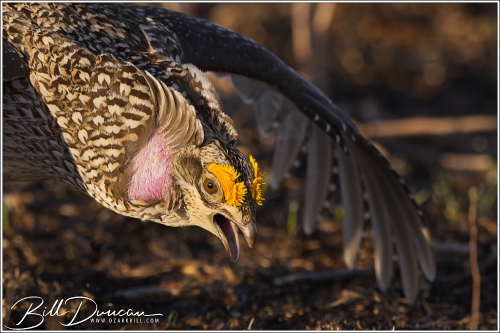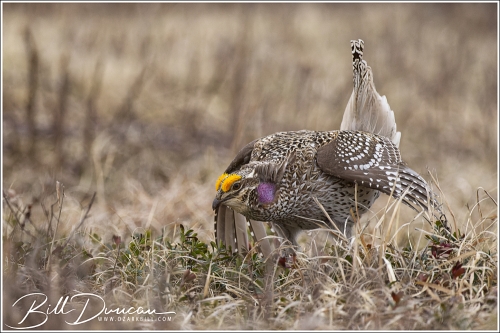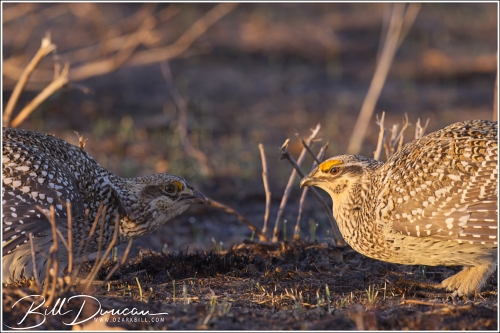In mid-April of this year, Casey and I took an exhilarating and unforgettable trip to Wisconsin to photograph Sharp-tailed Grouse. Every morning, my journey began with waking up at 3:00 am, filled with anticipation and excitement for the day ahead. It was an hour’s drive to get to the viewing blind, and arriving 30 minutes prior to first light was crucial, ensuring that we could witness the natural spectacle that was about to unfold.

As the first light of dawn broke through the horizon, the air was filled with the captivating sounds of nature coming to life. The distinct calls and rhythmic dancing of the Sharp-tailed Grouse on the lek echoed through the surroundings, creating an awe-inspiring symphony. The increasing light revealed the beauty of the birds that had already began their intricate dance on the lek, a sight that left an indelible mark on my memory.
Each day, we were fortunate to have very good views of the birds on the leks, with up to 17 magnificent creatures, mostly males, gracing the landscape with their presence. The vibrant plumage and graceful movements of the Sharp-tailed Grouse were a testament to the wonders of the natural world, and capturing these moments through my lens was an experience like no other.

I’m sharing some of the thousands of images I made during my three mornings on the leks throughout the post. I was also able to capture some video that showcases the tremendous sights and sounds of the lek activities. I love the variety sounds these birds create. From the percussive slap of their powerful feet on the ground, to the booms, cackles, yelps and snaps of their beaks, there is so much to take in when visiting a lek!
Summary of Conservation of the Sharp-tailed Grouse
Like so many wildlife species, the decline of Sharp-tailed Grouse populations began in the 19th century due to unchecked habitat loss caused by agricultural expansion, logging, and urban development. Unregulated hunting also contributed to population declines as settlers moved westward.
By the early 1900s, conservationists began to recognize the declining populations of Sharp-tailed Grouse and other wildlife species that were found across the landscape. State and federal governments implemented regulations on hunting seasons and bag limits to conserve grouse populations.
Conservation efforts in the mid to late 1900’s focused on habitat restoration and management. This included reforestation, prescribed burning, and grassland restoration projects aimed at creating suitable habitat for Sharp-tailed Grouse. Scientists conducted research to better understand the habitat requirements, behavior, and population dynamics of the species, which informed conservation strategies. Conservation organizations, government agencies, landowners, and other stakeholders collaborated on conservation initiatives to protect and restore Sharp-tailed Grouse habitat across its range.

More recent conservation initiatives include:
- Land Protection: Conservation organizations have worked to protect critical habitat through land acquisition and conservation easements.
- Community Engagement: Conservation efforts increasingly involve local communities through education, outreach, and participation in habitat restoration projects.
- Monitoring and Management: Continued monitoring of Sharp-tailed Grouse populations helps conservationists assess the effectiveness of conservation efforts and adjust management strategies as needed.
- Climate Change Considerations: Conservation efforts now take into account the potential impacts of climate change on Sharp-tailed Grouse habitat and populations, with adaptive management strategies being developed to mitigate these impacts.
Although the above mentioned efforts have made significant improvements in the populations of these birds in Wisconsin and other parts of their range, significant challenges remain that could influence the long-term outlook on this species.
- Fragmentation: Habitat fragmentation remains a significant challenge for Sharp-tailed Grouse conservation, as landscapes become increasingly fragmented due to development and other human activities.
- Predation and Disease: Predation and disease also pose threats to grouse populations, requiring ongoing management efforts.
- Socioeconomic Factors: Balancing conservation objectives with the needs and interests of local communities and landowners remains a challenge.
Despite these challenges, ongoing conservation efforts give hope for the continued survival and recovery of grouse populations across their range. By addressing habitat loss, implementing sustainable management practices, and engaging with local communities, conservationists aim to ensure a future where Sharp-tailed Grouse thrive in their natural habitats.
Habitat requirements for Sharp-tailed Grouse
The Sharp-tailed Grouse has specific habitat requirements that are essential for its survival and reproductive success. Understanding these key habitat requirements is crucial for effective conservation and management of the species. Here are the primary habitat requirements for Sharp-tailed Grouse:
- Native Grasslands and Prairie Habitat: Sharp-tailed Grouse are primarily associated with native grasslands and prairies. These habitats provide the open spaces, diverse vegetation structure, and ground cover necessary for the species’ breeding, nesting, and foraging activities. The presence of native grasses, forbs, and shrubs is important for providing food, cover, and nesting sites.
- Breeding and Nesting Habitat: During the breeding season, grouse require specific habitat features for courtship displays and nesting. Males perform elaborate courtship displays on traditional dancing grounds, known as leks, to attract females. The presence of suitable lekking sites with short, sparse vegetation and clear visibility is critical for successful breeding behaviors. Females seek out areas with dense grass cover and sufficient concealment for nesting, typically selecting sites with tall, dense grasses for nesting cover.
- Foraging Habitat: Sharp-tailed Grouse forage on a variety of plant materials, including seeds, insects, and forbs. High-quality foraging habitat consists of diverse plant species that provide a range of food resources throughout the year. Forbs, grass seeds, and insect-rich areas within the grassland habitat are important for meeting the species’ dietary needs.
- Adequate Space and Connectivity: The availability of large, contiguous expanses of suitable habitat is important for grouse. Connectivity between different habitat patches allows for movement, dispersal, and genetic exchange among populations. Fragmentation and isolation of habitat patches can limit the species’ ability to access resources and can increase vulnerability to environmental pressures.
- Disturbance and Predator Management: Sharp-tailed Grouse benefit from habitat that is managed to minimize disturbances and reduce predator impacts. Controlled grazing, prescribed burning, and habitat management practices that create a mosaic of different vegetation types can provide a balance of cover and foraging opportunities while reducing predation risks.
- Seasonal Habitat Needs: The species requires habitat that meets its seasonal needs, including suitable wintering areas with access to food and cover during the colder months. Additionally, habitat that provides protection from extreme weather conditions, such as snow and wind, is important for the species’ survival.
Understanding and addressing these key habitat requirements is essential for the conservation and management of Sharp-tailed Grouse populations. Conservation efforts that focus on preserving and enhancing native grassland and prairie habitats, maintaining habitat connectivity, and implementing sustainable land management practices play a critical role in meeting the species’ habitat needs.

About our Wisconsin Setting
I was fortunate to be able to visit leks at two different locations in northwestern Wisconsin. Many thanks to the organizations who manage these areas and helped us a lot by providing viewing blinds and giving me information on where to find these leks!
Solon Springs Sharptail Barrens
Before European settlers arrived in the area, the Solon Springs region was inhabited by indigenous peoples, primarily members of the Ojibwe (Chippewa) and Dakota Sioux tribes. These Native American communities lived in harmony with the land, utilizing its resources for sustenance, shelter, and cultural practices. The barrens likely played a role in their seasonal hunting, gathering, and ceremonial activities.

European exploration of the Great Lakes region brought French fur traders and explorers into the area in the 17th and 18th centuries. The dense forests and expansive wetlands of northwestern Wisconsin presented challenges to early settlers, but as the fur trade expanded, trading posts and small settlements began to emerge.
By the mid-19th century, the timber industry became the dominant economic force in the region. The vast forests of white and red pine attracted lumber companies, leading to extensive logging operations throughout northwestern Wisconsin. The Solon Springs area was no exception, and its forests were heavily exploited for timber to meet the growing demand for lumber in rapidly developing urban centers.
As logging operations expanded, concerns about deforestation and its environmental impacts grew. Conservation movements began to gain momentum in the late 19th and early 20th centuries, leading to the establishment of forest reserves and parks to protect natural areas. In 1927, the Wisconsin Department of Natural Resources (DNR) designated the Solon Springs Sharptail Barrens as a State Natural Area, recognizing its unique ecological significance and the need for preservation.
The Solon Springs Sharptail Barrens are characterized by a unique mix of grasslands, shrublands, and scattered pine and oak forests. This mosaic of habitats supports a diverse array of plant and animal species, including the iconic Sharp-tailed Grouse, which relies on the barrens for breeding and foraging habitat. Other species found in the area include various grassland birds, mammals, reptiles, and insects, making it a hotspot of biodiversity in the region.
In addition to its ecological importance, the Solon Springs Sharptail Barrens attract outdoor enthusiasts seeking opportunities for hiking, birdwatching, photography, and nature appreciation. The Wisconsin DNR manages the area to balance conservation goals with compatible recreational activities, ensuring that visitors can experience and enjoy the natural beauty of the barrens while minimizing human impacts on sensitive habitats.
Despite its protected status, the Solon Springs Sharptail Barrens face ongoing threats from factors such as habitat fragmentation, invasive species, and climate change. Conservation efforts continue to focus on maintaining and restoring the ecological integrity of the area through habitat management, invasive species control, and scientific research. Public education and outreach also play a crucial role in raising awareness about the importance of preserving this unique natural treasure for future generations to enjoy.

Crex Meadows State Wildlife Refuge
The land that is now Crex Meadows has a long history of human habitation, with Native American tribes, including the Ojibwe, Potawatomi, and Dakota, using the area for hunting, fishing, and gathering.
In the early 20th century, the Crex Carpet Company began purchasing land in the area for peat extraction to produce carpets. However, the company eventually abandoned its plans, leaving behind large tracts of abandoned land. During the Great Depression, efforts to revitalize the local economy led to the establishment of the Crex Meadows Wildlife Area in 1937 by the Federal Emergency Relief Administration (FERA) and the Civilian Conservation Corps (CCC).

The CCC played a crucial role in the development of Crex Meadows, constructing roads, trails, dikes, and water control structures to manage the wetland habitat for wildlife. Over the years, the refuge expanded through land acquisitions and partnerships with conservation organizations. Today, it encompasses over 30,000 acres of diverse habitats, including marshes, flowages, forests, and grasslands.
Crex Meadows is renowned for its wildlife management programs, which aim to conserve and enhance habitat for a wide variety of species, including waterfowl, shorebirds, songbirds, mammals, and reptiles. The refuge is also a hub for research and education, hosting numerous studies on wetland ecology, migratory bird patterns, and habitat management techniques. Educational programs and guided tours offer visitors the opportunity to learn about the area’s natural history and conservation efforts.
A brighter future for Sharp-tailed Grouse in Wisconsin?
While specific population trend data for Sharp-tailed Grouse in Wisconsin may vary by region and over time, conservation efforts have aimed to address habitat needs, reduce threats, and support the recovery of the species. Habitat restoration projects, collaborative partnerships, and sustainable land management practices have been implemented to enhance and protect suitable habitat for grouse in the state.
Given the complex and dynamic nature of population trends, ongoing monitoring and adaptive management remain essential for understanding and addressing the conservation needs of grouse in Wisconsin. By integrating scientific research, policy interventions, and community involvement, conservationists aim to ensure the long-term viability of Sharp-tailed Grouse populations.

Collaborative partnerships have played a crucial role in advancing Sharp-tailed Grouse conservation efforts in Wisconsin. These partnerships have involved government agencies, non-profit organizations, private landowners, and local communities working together to address habitat needs, implement conservation initiatives, and engage stakeholders in the conservation of the species. Here are some examples of successful collaborative partnerships for grouse conservation in Wisconsin:
- Wisconsin Department of Natural Resources (WDNR) and Non-profit Organizations: The WDNR has collaborated with non-profit conservation organizations, such as The Nature Conservancy, Pheasants Forever, and local land trusts, to implement habitat restoration projects, land acquisitions, and conservation easements aimed at protecting and enhancing Sharp-tailed Grouse habitat. These partnerships have leveraged funding, technical expertise, and community engagement to support conservation actions.
- Private Landowner Conservation Agreements: Collaborative partnerships between private landowners and conservation organizations have resulted in the establishment of conservation agreements to protect and manage critical grouse habitat on private lands. These agreements may include voluntary conservation easements, habitat management plans, and financial incentives to support landowners in implementing habitat-friendly land management practices.
- University Research Collaborations: Collaborative partnerships between academic institutions and wildlife management agencies have facilitated research studies and monitoring efforts focused on Sharp-tailed Grouse populations and habitat. These partnerships have contributed to the generation of scientific knowledge, data collection, and the development of evidence-based conservation strategies.
- Community-Based Conservation Coalitions: Local conservation coalitions and grassroots organizations have formed partnerships with landowners, hunters, and community members to promote grouse conservation at the grassroots level. These coalitions often engage in habitat restoration projects, educational outreach, and collaborative monitoring efforts, fostering a sense of shared stewardship and local support for conservation actions.
- Working Lands for Wildlife (WLFW) Partnerships: The WLFW program, in collaboration with federal and state agencies, has engaged private landowners and agricultural producers in Wisconsin to implement habitat-friendly agricultural practices that benefit grouse and other wildlife species. These partnerships have provided technical and financial assistance to landowners for implementing conservation practices on working agricultural lands.
- As an aside, I have had experience in WLFW in the St. Louis area during my career at Monsanto/Bayer. I can attest that this program can add valuable habitat using “unused” corporate lands for the benefit of floral and faunal communities.
These examples illustrate the diverse and impactful collaborative partnerships that have been instrumental in advancing Sharp-tailed Grouse conservation in Wisconsin. By fostering collaboration, leveraging resources, and engaging stakeholders, these partnerships have contributed to the protection and enhancement of critical habitat, the implementation of sustainable land management practices, and the promotion of community involvement in conservation efforts.

From materials I browsed from the Wisconsin Department of Natural Resources and seeing first-hand the excellent management practices ongoing at Solon Springs Sharptail Barrens and Crex Meadows State Wildlife Refuge, it seems the population of Sharp-tailed Grouse is currently in good hands in the Badger State.

Hopefully you have enjoyed a look at some of my experiences during three days on the lek with these fantastic chickens. Thanks so much to Casey Galvin for doing most of the planning for this adventure. Thank you also to Lauren Thomas of the Wisconsin DNR for helping me identify a lek at Crex Meadows on very short notice. Finally, thanks so much to my darling wife Sarah, for taking care of some of my responsibilities around the house while I was away on this trip!
-OZB








Interesting post and great photos as always. Here in north central Colorado we have both dusky and sharpies. But mostly sharpies. The sage brush provides cover while my small lawn and driveway serves as a lek. Being so close to our house makes for great viewing. I’m always surprised at how loud a boom they make. Thanks for the post.